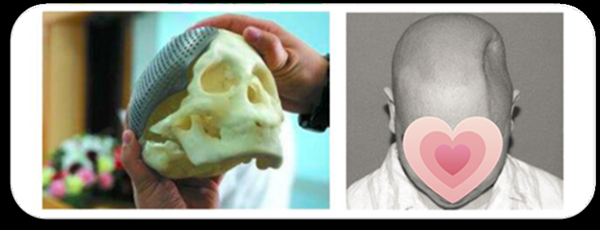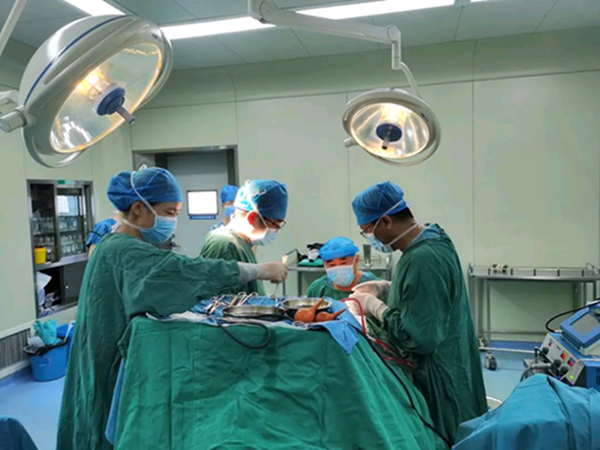The first application of polyether ether ketone (PEEK) to repair a cranial defect in the first neurosurgical ward of the First Affiliated Hospital of Xi'an Medical College's Brain Hospital marked a new level of neurosurgical technology in the hospital. Six months ago, 48-year-old Mr Zhang (a pseudonym) fell off a ladder while working and was admitted to the first neurosurgery ward of the First Affiliated Hospital of Xi'an Medical College in an emergency, where doctors diagnosed him with a heavy craniocerebral injury, right subdural haematoma and brain hernia. After completing relevant tests, Professor Liu Weiping, the honorary president, and Ding Zhibin, the director, led the team to perform an open cranial hematoma removal + decompression of the bone flap for Mr. Zhang. After the operation, Mr. Zhang turned critical and recovered well. He was admitted to the hospital for further treatment of the skull defect left over from the previous surgery.

"The human skull consists of 23 irregular bones that support and protect brain tissue. In adults, traumatic skull defects are the result of depressed comminuted skull fractures, open craniosynostosis, and heavy closed craniosynostosis combined with refractory cranial hypertension and decompression of the flap. When a skull defect is present, the brain tissue lacks a protective cranial barrier and is at risk of serious consequences when re-encountering head trauma. At the same time, patients can suffer from changes in body position, resulting in repeated depression and bulging of brain tissue, which can lead to metabolic disorders and dysfunction of brain tissue under the action of external atmospheric pressure, and changes in external temperature can also stimulate brain tissue, and patients can experience varying degrees of vertigo, dizziness, irritability and fatigue, memory loss, depression, insecurity and various mental disorders." Director Ding Zhibin explains.
The treatment indications for skull defect repair surgery are: 1) skull defect >3cm in diameter; 2) the defect area is aesthetically displeasing; and 3) the presence of clinical symptoms associated with the skull defect. The timing of surgery should be 6-12 months after surgery, while some experts advocate early cranioplasty (within 3 months).
Materials used for skull repair include pure titanium and polyether ether ketone (PEEK). The advantages of pure titanium are: 1) good corrosion and wear resistance; 2) excellent biocompatibility; 3) no intraoperative treatment of the bone window margin; 4) thin, lightweight plates; 5) fibroblasts can grow into the micro-pores of the titanium mesh. Disadvantages: 1. artifacts on CT, MRI and X-ray; contraindicated in patients with metal allergy; 2. sharp edges may cut the skin and cause chronic cutaneous ulcers resulting in exposure of the repair; 3. difficult to shape perfectly in areas with large natural corners of the skull, such as the frontal prominence and the arch of the eyebrow; 4. conductive and heat-conductive, cannot be left in too cold or too hot an environment for too long; 5. may be deformed by external forces; 6. The implant may be exposed.
The advantages of polyetheretherketone (PEEK) are: 1. good implant comfort: light material, thermal insulation; 2. good biocompatibility; non-conductive, dispersed stress, impact resistant; 3. good imaging performance: no artefacts, good X-rays, CT scans, MRI; 4. good anatomical reconstruction: 3D modelling to reconstruct the anatomical form for a perfect fit. The disadvantage is that it is more expensive. The use of PEEK material for repair, on the other hand, requires the embedded fitting of the repair material to the defective skull, which requires careful peeling along the outer layer of the dura mater to fully expose the bone margins during surgery, making the procedure more difficult compared to titanium metal plate covered implants.

After full communication with the patient and family, Mr Zhang and his family finally decided to use polyether ether ketone (PEEK) material to repair the defective skull. "I actually made a lot of enquiries, and although titanium plates are cheap, they have certain drawbacks. Old Zhang has had a hard life, so we discussed it at home and decided to use a better repair material for him this time." Zhang's loved ones said.
Cranial repair surgery is the icing on the cake in neurosurgery. Although the repair surgery is minor, it is prone to serious complications such as infection, rejection and implant exposure. In order to meet the patient's needs and to ensure that the surgery was carried out safely, the team of experts went through a thorough pre-operative examination, discussion and the formulation of a well thought out surgical plan. With the full cooperation of the Department of Anaesthesia and Surgery, the specialist team performed the PEEK material skull repair on Mr. Zhang and the surgery went smoothly. After the surgery, Mr. Zhang recovered well and has been discharged from hospital.



